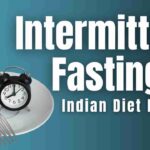Once in a lifetime, you must have debated “good carbs vs bad carbs” with your friends, family, or anyone who matters to you. Especially if you are a weight loss aspirant, then there is no doubt about it that you want to explore various aspects of carbs such as a list of good carbs and bad carbs food, the best high protein low carbs snacks, Should I need to avoid carbs to lose weight, or maybe best low carbs fast food breakfast, and so on.
Carbs are the primary energy source for our body cells and can help optimize physical and mental performance. Despite that, carbs are regularly trolled and categorized into good carbs & bad carbs lists, especially concerning weight loss and weight gain. So, why is the controversy? You will get the answer as we move forward in this article about “good carbs and bad carbs,” and you will be clear whether there is such a thing.
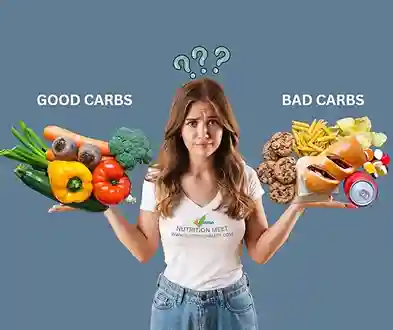
Table of Contents
What are carbs?
When we talk about carbohydrates in short, which are also called ‘carbs,’ we are addressing sugar, starch, and fiber. They are macronutrients naturally found in plant-based foods. Moreover, carbs can also be divided into ‘simple and complex carbs.’
Role of Carbohydrates
- Primary dietary source of energy for all living organisms.
- In the form of glycogen, energy is stored to meet immediate energy demands.
- Carbs are precursors for many organic compounds like fat and amino acids.
- The form of glycoprotein and glycolipids participates in the structure of cell membranes, cell growth, fertilization, and cellular function.
- Carbs also preserve muscles, promote digestion, aid in the regulation of nerve tissue, and provide energy to the brain.
Good carbs vs Bad carbs: myth or fact.
We have seen an extensive list of the important role played by carbohydrates still why carbs are the “enemy nutrient.” Which carbs are good for you? Which carbs are bad for you?
For a strong understanding of good carbs and bad carbs, score the carbohydrates based on three criteria, i.e., “simple v/s complex,” “Fast v/s slow,” and “Low fiber v/s high fiber.” Let’s understand all these criteria before jumping to a conclusion.
Simple v/s complex
Simple carbohydrates:
They are sugars that contain only one or two molecules. Most importantly, simple carbs are the primary source of instant energy and, similarly, get digested quickly, activating your hunger hormones within a short period. The source of simple carbs is white bread, sugars, and candies [1].
Complex carbohydrates:
They are long chains of sugar molecules. Complex carbs contain more vitamins, fiber, and minerals and slowly get absorbed by the body. According to the United States Dietary guidelines, “the proportion of energy coming from carbohydrates should be 40-50% out of which simple carbs contribution should be not more than 10%”. The sources of complex carbs are whole grains, vegetables, fruits, and pulses [1].
Fast v/s Slow
These criteria score carbohydrates based on how they affect your blood glucose; technically speaking, what is that food’s “glycemic index”? The glycemic index (GI) is a system of scaling carbohydrates based on how much or how fast food is converted to glucose in your blood. A higher GI score above 70 means they elevate glucose levels faster. In contrast, a lower GI score below 55 means the steady release of glucose in the blood and the maintenance of more sustainable energy [2]. Moreover, high GI is linked with weight gain, and a higher risk of type 2 diabetes, and heart disease [3].
Low fiber v/s High fiber.
Fiber is universally known to be stuffed in fruits, vegetables, and whole grains that keep us regular. The low fiber or fiber deficiency in your means there is no check on the release of glucose in your blood, and your blood glucose level might shoot up within no time. Therefore, a low-fiber diet is associated with dozens of diseases, specifically cancer, diabetes, diverticulosis, and gallstones [2].
Now that you thoroughly know all the criteria, it’s easy to decipher that foods high in fiber, low in Glycemic index, and complex in nature benefit our body and vice versa. So, in simple terms, carbs that are complex, slow, and high in fiber can be considered “good carbs” to nourish our body, and in contrast, carbs that are simple, fast, and low in fiber can be considered “bad carbs” since more than nourishment they are the cause of disease.
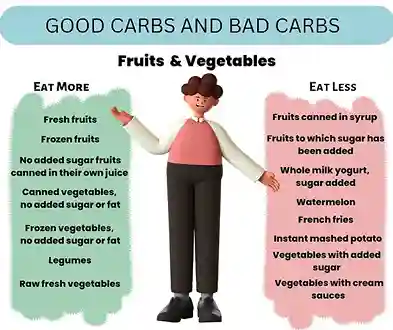
Which carbs to eat and which carbs to avoid
Extensively, vegetables, whole grain cereals, and fruits are the source of complex carbs and are counted into good carbs, but when it comes to GI list shakes a bit since we can’t say all ‘fruits carbs are bad or good,’ and similarly, not all vegetable carbs are good and will have a low GI value or high fiber.
For instance, watermelon is a fruit but contains simple sugars, low fiber, and high GI; in the case of carrots, they have a relatively good amount of fiber but a high GI of 71. In fact, the GI values of some foods like ice cream are low, but it is still a simple sugar and may not be suitable for you [3].
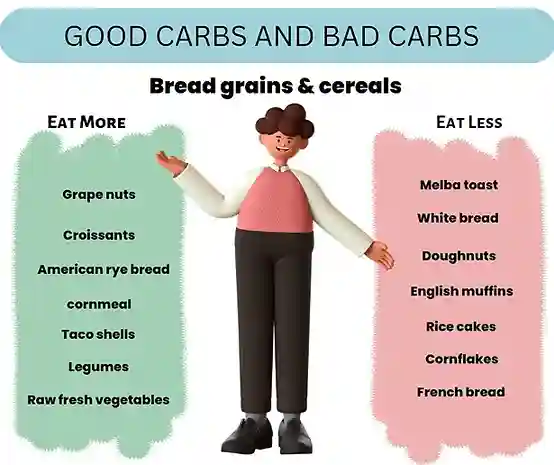
Therefore, it is crucial to mix and match the meal ingredient with protein, fiber, and fat to make the complete meal complex low in GI, and high in fiber. For example, potatoes and pumpkins are relatively on the higher GI side yet highly nutritive; if you exclude them, you will miss a lot of nutrients. Thus, it is a wise decision to combine complex carbs with other low GI, high-protein, and high-fiber if the GI of that food is high [3].
Another care you need to take care of is that you are avoiding refined grains and products made up of highly processed/refined carbs; they are not the only reason for weight gain but also the reason for various health-related problems like heart disease. Indeed they are examples of bad carbs.
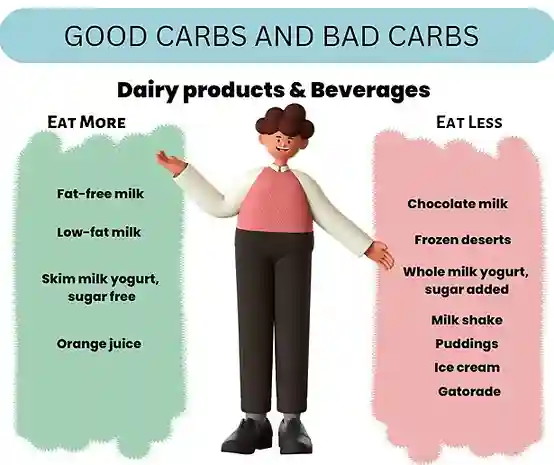
Should I cut carbs to lose weight?
According to the study conducted when overweight but healthy adults offered high carbs/low-fat breakfast led to higher postprandial insulin, acute increase and decrease in peak concentration, and more hunger at 3 to 4 hours post meal consumption. This pattern cues toward an increase in the frequency of food consumption, which means more calorie gain and weight gain in the long run [4].
Although carbs are the primary source of energy, there is a tendency for faster absorption and episodes of frequent eating as compared to fat and protein. Therefore, to lose weight, improve cardiovascular health, and reduction in insulin resistance, it’s essential to reduce the carb intake and increase fat and protein to feel fuller for longer [5, 6].
Conclusion
The criteria for good carbs and bad carbs are simple, before consuming any high-carb food, is this an example of complex, low Glycemic index, and high fiber? If you get an answer as yes, then you can consume it but in combination with protein and fat to decrease the GI of the meal. The perfect example of a bad carb is refined foods and sugars, which are nothing but empty calories with minimal nutrients; moreover, while setting priorities, you can also check whether a particular food is simple carbs, high GI, and low fiber.
FAQ
Is white bread bad for you?
The white is made up of processed flour; therefore, consuming too much white will lead to obesity, heart disease, and Type 2 diabetes.
Which are the best carbs after a workout?
1. Oats
2. Peanut butter and whole-grain bread
3. Post-workout recovery fruit smoothies
4. Gur chana
5. Whole grain cereals and skim milk
Which are the best high-protein, low-carb snacks?
1. Protein bars
2. Biena roasted chickpeas snacks.
3. Pistachios, and other nuts
4. Hard-boiled egg
5. Popcorn
Best low-carb fast food breakfast?
1. Bacon and eggs
2. Banana chia seed smoothie
3. Lettuce-wrapped burger
4. Chipotle salad
5. Grilled chicken
6. Panera bread power breakfast bowl
Good carbs for weight loss?
1. Barley
2. Acorn squash
3. Legumes
4. Whole wheat bread
5. Black beans
6. Oatmeals
7. Quinoa
8. Broccoli
9. Blueberries
10. Buckwheat
Best low-carb alcoholic drinks?
If you are strictly low-carb or keto diet, you can drink a glass of Wine.
Which are high-carb foods?
Doughnuts
Soda
Potato and corn chips
French fries
A sugar bowl of cereals
Milkshakes
Cake with frosting



